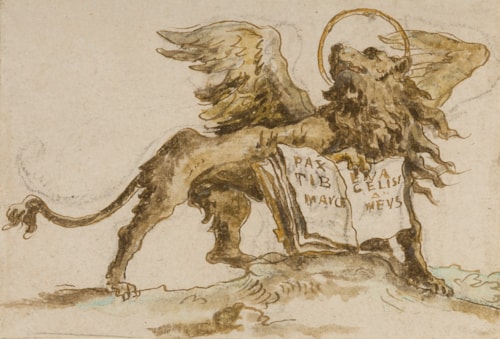
Francesco GUARDI
Venice 1712 - Venice 1793
Biography
Francesco Guardi is thought to have trained in the studio of his brother-in-law, Giovanni Battista Tiepolo. Unlike Canaletto or the Tiepolos, however, he never seems to have sought fame abroad, preferring instead to remain almost exclusively in and around his native Venice. For much of his early career Guardi worked as a history painter, often in collaboration with his elder brother Gian Antonio, and it was not until quite late in his life - indeed, already in middle age - that he took up the vedute painting for which he is best known today. He may even have been an assistant in the studio of Canaletto in the late 1750s or early 1760s, to judge from a contemporary description of him in 1764 as ‘a good pupil of the celebrated Canaletto’, although this is by no means certain. Guardi did, nevertheless, borrow liberally from Canaletto’s compositions throughout his career.
By 1761 Guardi had joined the painter’s guild in Venice, and soon established a reputation as a painter of Venetian views and imaginary landscapes, or capricci. He enjoyed a market for his views of Venice, painted with loose, spirited brushwork and transparent washes which allowed the artist the freedom to explore atmospheric effects. While he was fairly successful as a view painter, Guardi never achieved the level of fame enjoyed by Canaletto, particularly among foreign visitors to Venice. Nevertheless, his work was popular with British tourists to the city, and among his patrons was the English diplomat John Strange, the British resident in Venice between 1773 and 1790, who commissioned a series of view paintings of country villas on the terraferma. It was not until 1784, at the age of seventy-one, that Guardi was admitted to the Accademia in Venice, as a ‘pittore prospetico’. His son Giacomo was also an artist, and continued the family studio well into the 19th century.
As Rudolf Wittkower has written, ‘Francesco Guardi’s art has often been compared with the music of Mozart. Despite his modernity, Guardi was a man of his century and, more specifically, a man of the Rococo. He continued creating his spirited capriccios and limpid visions of Venice long after the spectre of a new heroic age had broken in on Europe. When he died in the fourth year of the French Revolution, few may have known or cared that the reactionary backwater of Venice…had harboured a great revolutionary of the brush.’
A gifted draughtsman, Guardi was a prolific and spirited master of the pen. (Antonio Morassi listed over 650 drawings by the artist in his catalogue raisonné of 1984.) As has been noted, ‘There was something of Watteau in his make-up; he was seldom without a sketchbook at hand in which to jot down anything that took his fancy whether or not it was used in a painting later on.’ Guardi’s drawings include sheets of studies of figures and boats, architectural scenes, designs for wall and ceiling decorations, landscape capricci and topographical Venetian views. ‘By 1765 or so’, as another scholar has written, ‘Guardi had developed his personal style, in which a nervous, flickering line and subtly and richly varied washes give an atmospheric brilliance and luminosity that transform the subject into pictorial enchantment.’
A large and varied collection of drawings by the artist is today in the Museo Correr in Venice, acquired by Count Teodoro Correr from Giacomo Guardi. These are, however, mostly sketches and quick studies for pictures, rather than large-scale, finished sheets, and as such represent the typical contents of an artist’s workshop. Smaller but significant collections of drawings by Guardi are today in the British Museum and the Courtauld Gallery in London, the Pierpont Morgan Library and Metropolitan Museum of Art in New York, the Ashmolean Museum in Oxford and the Louvre in Paris.





